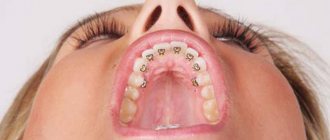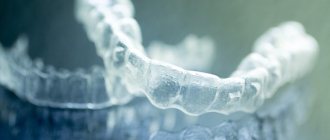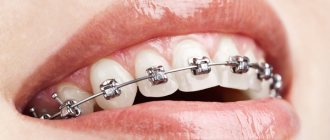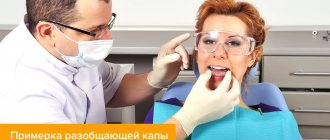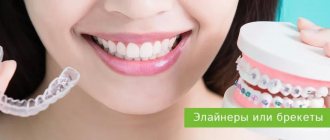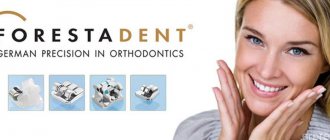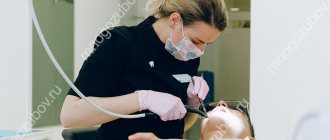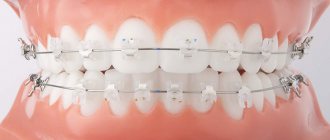The brand name comes from the English word “invisible”, which means “invisible”. They are truly invisible even from a distance of 20-30 centimeters, which makes them the most aesthetic option for correcting a bite.
Invisalign was the very first aligner to appear on the orthodontic market. All other brands focused specifically on this system, which today has existed for more than 20 years. The company created a real revolution in the field of bite correction and won recognition among doctors and patients around the world.
Indications for installation
- crowding of teeth (except in severe cases),
- gaps in the dentition: trema and diastema,
- slight displacement of the teeth of one jaw relative to the other,
- incorrect position of one or more teeth,
- use from the age of 12-13 years.
Brand benefits
- highest aesthetics,
- fast and predictable results,
- individual production using computer modeling,
- the most famous aligner system with a long history,
- patented material that does not cause allergies.
Expert opinion
Rustamova Gunel Bakhmanovna Dentist-orthodontist Work experience 4+
“Contrary to popular belief, Invisalign aligners can solve almost any bite problem – even difficult cases. This is confirmed not only by my personal practice, but also by numerous clinical studies1.”
Among the disadvantages of Invisalign aligners is their rather high price. It is due to the use of computer modeling of the treatment process, the use of expensive materials, as well as the delivery of a complete set of mouth guards from the manufacturer.
Information about the brand and its manufacturer
The manufacturer of Invisalign aligners is the international company Align Technology, established in 1997 in the USA. It produces medical products. In addition to mouth guards, it manufactures intraoral scanners and also sells digital OrthoCAD services.
The products of this manufacturer are used by the best dental clinics in the world. The high quality of the product is confirmed by the fact that, since 1999, with their help more than 5 million people have effectively solved problems associated with occlusion.
Invisalign aligners are made from a clear polymer biosilicone. It is a medical grade thermoplastic material. It does not cause allergic reactions, and therefore products made from it are suitable for all people.
Why is Invisalign considered orthodontic perfection?
Among orthodontic bite correction systems, Invisalign occupies a special place. Due to the success of the treatment results, doctors from all over the world became interested in the system. It is popular today in all countries and on all continents. Possessing an excellent orthodontic effect, it allows for gentle correction. A person with an orthodontic problem quickly gets used to the aligners, gets used to the aligners and stops noticing them. Today you can find orthodontic aligners in Moscow in many clinics. We offer an American system; smile correction will be as comfortable as possible, quickly, without pain, discomfort and unpleasant sensations. To find out how much they cost, call us by phone or call a specialist in the online window that pops up on the site.
Types of correction programs
The essence of the action of aligners is to move teeth in the process of synchronized directed mechanical action. At each stage of therapy, certain dental elements move according to a pre-developed plan.
There are 3 adjustment programs. They are differentiated depending on the complexity of the existing defect and, accordingly, on the number of aligners:
- SuperLite – up to 7 pieces;
- Lite – up to 14;
- Full – from 10 to 40 pieces.
The choice of program is made by the doctor, in accordance with the patient’s initial data.
Invisalign bite correction is not noticeable from the outside
Invisalign aligners or American aligners have shown high effectiveness in straightening teeth. They are invisible in the rows as they have a transparent base. Only he himself knows that the patient is undergoing bite correction. With Invisalign you can communicate, smile, talk freely. Fitting as tightly as possible to the rows, the mouth guards create directed pressure at the right points, forcing the teeth to move along the trajectory intended for them. The effect will remain unchanged - the aligners are completely invisible in the rows and do not attract attention. Comparing the effectiveness of aligners and braces, many experts note that the former win in 30% of orthodontic treatment cases. Invisalign aligners significantly reduce treatment time and make the correction process more comfortable for the patient.
The result before and after correcting the bite with Invisalign aligners.
Indications and contraindications for treatment with the Invisalign system
Like any method, treatment with aligners has its own indications and contraindications.
Correction using the Invisalign system is indicated:
- in case of violation of occlusion, including with deep vertical overlap;
- in the presence of diastemas;
- with crowding of dental elements.
Aligners are not used:
- in correcting malocclusion in children under 12 years of age;
- in the presence of mental illness;
- for bone tissue abnormalities.
Stars who wore aligners
Most celebrities cannot afford to wear braces, so Invisalign aligners have become a real salvation for them.
Gisele Bündchen
The only flaw in Giselle's appearance was once a crooked front tooth, for the sake of straightening which she put on aligners.
Zac Efron
Many celebrities are proud of their gap hair, but not Zac Efron. The gaps between his front teeth gave him a rustic appearance. Thanks to wearing aligners, the actor’s appearance changed dramatically.
Khloe Kardashian
Socialite Chloe always thought she had uneven teeth and wanted to fix them, but only decided to undergo orthodontic treatment last year.
Justin Bieber
A favorite of teenage girls, sweet-voiced Justin would never agree to ruin his image and put braces on his teeth. The Invisalign system helped him achieve his perfect smile.
Eva Longoria
Desperate housewife Eva Longoria is rarely tormented by doubts. I decided to correct my crooked teeth - I chose Invisalign - and that was the end of it!
What is included in the diagnosis
Preliminary diagnostics in our clinic are performed using high-precision imported X-ray equipment ORTHOPHOS XG. This stage is necessary to identify indications and contraindications for occlusion correction using aligners.
The second stage of diagnosis is making individual impressions or scanning with an iTerro device, which allows you to create a 3D model of the jaws. Based on this model, personal mouth guards will subsequently be manufactured in production in the USA. When using this technology, there is no need to make physical impressions.
Based on the data obtained, a step-by-step therapy algorithm is developed using special software. ClinCheck technology allows digital interpretation to predict the progress of defect correction and visualize the final result. It should be noted that our clinic’s specialists are certified to use Align Technology products.
Food and drink intake, habits. What is better - braces or aligners?
| Eating and drinking habits | ALINERS | BRACKETS | VENEERS |
| Restrictions on food intake (diet) | Hardly ever | Yes | Yes |
| Can be removed while eating | Yes | No | No |
| Eating solid foods (nuts, crackers, etc.) | yes (without aligners, need to be removed) | No | Yes |
| Getting food between teeth when eating | No | Yes very many | No |
| Residual odor from the mouth after eating | No | Yes | No |
| Eating food with dyes | No | Yes | No |
| Alcohol consumption (over 21 years of age) | no pattern | no pattern | no pattern |
| Smoking (contraindicated when wearing or not) | acceptable | acceptable | acceptable |
Here is perhaps the most interesting information for patients. Since we eat every day and several times. Additional structures in the form of braces, aligners or veneers should, in theory, make eating problematic. After all, they can break and come off. Is it so?
Aligners have no restrictions on food intake. Braces have a lot of
No matter how strange this statement may seem, aligners are significantly superior to braces and veneers for one, but cool, reason - they can simply be removed when eating. You will not have this option if you wear braces or veneers. Therefore, if you are a food lover and cannot deny yourself the desire to chew nuts, crackers and other hard treats, make the right choice. And even if you eat in the aligners, the risk of damaging the aligner itself, although present, is extremely small, since the aligners are a fairly strong mouthguard made of special plastic.
Orthodontists recommend wearing aligners 20-22 hours a day. This means you have 2-4 hours to eat and drink. This is more than enough to eat without problems.
Braces are the leading cause of food getting stuck. Aligners are the best!
The presence of rigid bridge-like structures on the teeth in the form of wire between the braces has given the undisputed leadership in the area of food stuck to braces. Everything you eat for breakfast, lunch and dinner gets stuck in the space between the tooth and the wire. And the design of the braces themselves, which are attached to the teeth, is such that food also clings to them and remains. And, if you don’t clean out food debris, it may stay in the mouth longer than usual - at least an odor appears. And the maximum is deposits on the teeth, which can lead to the destruction of its enamel. Deposits on the teeth, plaque around braces and in places where food often gets stuck - this is not the case with aligners for one simple reason: you can remove the aligners and brush your teeth normally.
Subsequent brushing of teeth and oral hygiene (more on them below) is a complete headache for the patient. Every day, several times and much more carefully than usual. Are you ready for such a waste of time? - then this should not prevent you from installing braces.
Veneers and aligners “do not suffer from the problem” of additional teeth cleaning, since food CANNOT get stuck in the aligners, and when eating food, veneers behave just like regular teeth with appropriate subsequent care for them.
Teeth brushing and oral hygiene: braces are underdogs. Veneers or aligners?
| Brushing teeth and oral hygiene | ALINERS | BRACKETS | VENEERS |
| Difficulty with hygiene | No | Yes | No |
| The need to brush your teeth after every meal | no (rinse) | Yes | no (rinse) |
| Brushing teeth as usual without additional equipment | Yes | no irrigators, brushes, mono-beam brush | Yes |
| Possibility of using dental floss for cleaning | yes (optional) | yes (required) | yes (optional) |
| Possibility to use toothpicks | yes (optional) | yes (required) | No |
| Using special toothbrushes | No | Yes | No |
| The need to update your toothbrushes | Standard | on average once every 3 weeks (high wear) | Standard |
What do we see in the table?
As we can see from the comparison table, the teeth that are the most difficult to care for are
- when wearing braces. There’s so much that’s missing here, look how many worries arise:
- Do you need to brush your teeth and between braces after every meal? - Necessary
- Will regular brushes work? - No, we need special ones and they are used up quickly
- Is your teeth brushing routine? - No, you need jewelry and acrobatic precision to clean all the nooks and crannies of the braces supports and the contacts of the supports with wire, rubber bands, etc. quiet horror…
- dental floss? - OF SURE, the leftover food will be impatiently waiting, absurdly stuck in the braces and tooth crevices when you pull them out with a creak.
- what if you don't clean it well? — The smell of decomposing food will not take long to arrive. Brrrrrr
Second place in terms of cleaning difficulties
- veneers. In principle, there are no particular problems cleaning veneers. These are actually second teeth, tightly adjacent to the first, but ground. Here you need to think more about the quality of food, constantly check: what you eat is not particularly solid. And - constantly shake - what if it falls off and exposes the terrible skeleton/stump of the former tooth.
And there is also a huge problem with veneers: you need to know which clinic is the right place to install them. Well, patients suffer a LOT of complications due to negligence when attaching veneers. Look how it happens, don't watch it for the faint of heart!
Oh, well, we forgot the main thing - we’re talking about veneers here, but veneers are not a method of correcting a bite. This is an invasive procedure that changes the structure of the teeth. After veneers, teeth cannot be restored and you will have to wear veneers for the rest of your life.
In case of braces and aligners
- there is no such thing, these are removable orthodontic structures that are put on for a certain period of time (the braces are rigidly attached, the aligners can be removed freely), and then - after treatment there is no need to wear them and all the patient’s teeth are in order, they are all his own, not turned.
First place for cleaning comfort - aligners
Everything is absolutely natural:
- took the aligners off my teeth, ate, brushed my teeth
- rinsed the aligners
- I put the aligners back on my teeth. ALL
During meals, the aligners can be stored in a personal box - box
Well, VERY convenient. See for yourself:
Wait, the girl here hasn’t packed the aligner in the box yet. Here you can better see how convenient it is:
How is the treatment carried out?
After the finished products are delivered from the USA to our center, the administrator notifies the patient about this by phone call and schedules an appointment time. With this visit to the orthodontist, the immediate course of correction begins.
The doctor explains the rules for wearing and the frequency of self-replacement of the aligners. The dentist also gives recommendations on how to care for your mouth and aligners. As a rule, the replacement is carried out by the patient himself once every 2 weeks. To check the effectiveness of the correction process, regular visits to our clinic are planned - approximately once every 1 - 2 months (depending on the complexity of the existing defect).
It is important for the patient to commit to wearing mouth guards daily and not to violate the recommendations of the attending physician. In addition, during the initial fixation of the corrective device and during its planned replacement, there may be a feeling of pressure on the teeth for several days. This phenomenon indicates that movement of the dental elements is initiated.
After achieving the result, a course of maintenance therapy is required, i.e. it is necessary to wear a retention device (or the last aligner from the kit). This consolidates the result and prevents the teeth from gradually returning to their original position.
Why is self-discipline needed?
- If a person experiencing certain inconveniences periodically removes the system out of self-pity, the program developed for him will be disrupted and the treatment may be ineffective.
- A set worn by mistake will also lead to the same result - for example, not the 5th, as scheduled, but the 6th. Each new mouthguard must strongly compress the teeth and move them a little more, and when worn incorrectly, the process is interrupted, which negatively affects its result.
- A duplicate of a lost or broken mouthguard will have to be ordered from an American laboratory, which will take time, and the next stage of correction will be skipped.
Duration of therapy
The time required to obtain the final result depends on the complexity of the clinical case. On average, according to the official Align Technology website, it takes about 1 year, which corresponds to 24 sets of aligners.
The doctor can announce the approximate duration of therapy in a specific situation only after diagnosis and development of an algorithm for the treatment process.
For teenagers
The Invisalign system is not used in children because it is intended only for fully formed teeth. But it is suitable for teenagers who have already lost all their baby teeth. The company specially developed a Teen version for them. This is a slightly modified version, better suited to the needs of teenagers. A special indicator is built into the design. It changes color if the device is not worn for the required number of hours per day.
Invisalign aligners are an ideal option for correcting minor malocclusions. But it is important to remember that good results are achieved only by carefully observing the timing of wearing each mouthguard.
Rules for wearing and care
Successful correction of occlusion is impossible without careful adherence to the orthodontist’s recommendations. Our dental center specialists advise:
- wear mouth guards daily for 22 hours;
- remove orthodontic products before eating or drinking hot drinks;
- brush or rinse the aligners with running water before each use;
- To clean the trays, use special pharmaceutical disinfectants or (if slightly dirty) a soft brush and paste. Note: Products cannot be boiled or washed with hot water;
- Use special containers for storage.
As you can see, the rules are simple and easy to follow.
Installation of braces
It is very simple to install this type of braces yourself: you just need to rinse the aligners with running water and carefully put them on the teeth. The device will automatically “fall into place” when you close your teeth and will not be felt at all in your mouth during conversations or eating (it is recommended to remove the aligners at home before meals so as not to injure them).
After a certain period of time, when the teeth have moved to the required distance, it is recommended to visit the dentist to receive a new mouthguard made from dental casts, taking into account the changes that have occurred in them.
The dangers of uneven teeth
Uneven teeth make them difficult to clean, which leads to tooth decay. They can also be easily injured. This pathology also leads to headaches, diseases of the ENT organs and eyes. And if there is no effective chewing of food, then the functioning of the gastrointestinal tract is disrupted. Serious consequences lead to malocclusions.
Straight teeth are the dream of many people. Anomalies appear from poor heredity, trauma or improper dental care in children. If they are crowded, teeth protrude from a row, or have other deficiencies, a visit to the orthodontist is required. Sometimes the problem is made up. Only a specialist can determine this. A preliminary diagnosis is made at the first appointment, and then the doctor offers treatment options.

